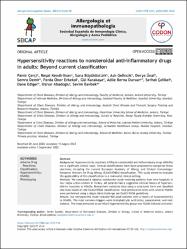Hypersensitivity reactions to nonsteroidal anti-inflammatory drugs in adults: Beyond current classification

Göster/
Erişim
info:eu-repo/semantics/openAccessTarih
2023AllergYazar
Çerçi, PamirKendirlinan, Reşat
Büyüköztürk, Suna
Gelincik, Aslı
Ünal, Derya
Demir, Semra
Erkekol, Ferda Öner
Karakaya, Gül
Dursun, Adile Berna
Çelikel, Serhat
Ediger, Dane
Abadoğlu, Öznur
Bavbek, Sevim
Üst veri
Tüm öğe kaydını gösterKünye
Çerçi, P., Kendirlinan, R., Büyüköztürk, S., Gelincik, A., Ünal, D., Demir, S., Erkekol, F. Ö., Karakaya, G., Dursun, A. B., Çelikel, S., Ediger, D., Abadoglu, O., & Bavbek, S. (2023). Hypersensitivity reactions to nonsteroidal anti-inflammatory drugs in adults: Beyond current classification. Allergologia et immunopathologia, 51(5), 84–92. https://doi.org/10.15586/aei.v51i5.946Özet
Background: Hypersensitivity reactions (HSRs) to nonsteroidal anti-inflammatory drugs (NSAIDs)
are a significant clinical issue. Several classifications have been proposed to categorize these
reactions, including the current European Academy of Allergy and Clinical Immunology/
European Network for Drug Allergy (EAACI/ENDA) classification. This study aimed to evaluate
the applicability of this classification in a real-world clinical setting.
Methods: We conducted a national multicenter study involving patients from nine hospitals in
four major urban centers in Turkey. All patients had a suggestive clinical history of hypersensitivity reactions to NSAIDs. Researchers collected data using a structured form and classified
reactions based on the EAACI/ENDA classification. Oral provocation tests with several NSAIDs
were performed using a single-blind challenge per EAACI/ENDA guidelines.
Results: Our retrospective study included 966 adult patients with a history of hypersensitivity
to NSAIDs. The most common triggers were Acetylsalicylic Acid (ASA), paracetamol, and metamizole. The most prevalent acute NSAID hypersensitivity group was NSAID-induced urticaria/

















